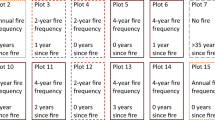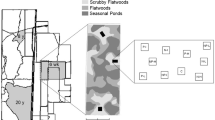Abstract
Although it is widely accepted that elevated atmospheric carbon dioxide (CO2), nitrogen (N) deposition, and climate change will alter ecosystem productivity and function in the coming decades, the combined effects of these environmental changes may be nonadditive, and their interactions may be altered by disturbances, such as fire. We examined the influence of a summer wildfire on the interactive effects of elevated CO2, N deposition, and increased precipitation in a full-factorial experiment conducted in a California annual grassland. In unburned plots, primary production was suppressed under elevated CO2. Burning alone did not significantly affect production, but it increased total production in combination with nitrate additions and removed the suppressive effect of elevated CO2. Increased production in response to nitrate in burned plots occurred as a result of the enhanced aboveground production of annual grasses and forbs, whereas the removal of the suppressive effect of elevated CO2 occurred as a result of increased aboveground forb production in burned, CO2-treated plots and decreased root production in burned plots under ambient CO2.The tissue nitrogen–phosphorus ratio, which was assessed for annual grass shoots, decreased with burning and increased with nitrate addition. Burning removed surface litter from plots, resulting in an increase in maximum daily soil temperatures and a decrease in soil moisture both early and late in the growing season. Measures of vegetation greenness, based on canopy spectral reflectance, showed that plants in burned plots grew rapidly early in the season but senesced early. Overall, these results indicate that fire can alter the effects of elevated CO2 and N addition on productivity in the short term, possibly by promoting increased phosphorus availability.





Similar content being viewed by others
References
Abrams MD, Knapp AK, Hulbert LC. 1986. A ten-year record of aboveground biomass in a Kansas tallgrass prairie: effects of fire and topographic position. Am J Bot 73:1509–15
Andersson M, Michelsen A, Jensen M, Kjøller A. 2004. Tropical savannah woodland: effects of experimental fire on soil microorganisms and soil emission of carbon dioxide. Soil Biol Biochem 36:849–58
Blair JM. 1997. Fire, N availability, and plant response in grasslands: a test of the transient maxima hypothesis. Ecology 78:2359–68.
Briggs JM, Knapp AK. 1995. Interannual variability in primary production in tallgrass prairie: climate, soil moisture, topographic position, and fire as determinants of aboveground biomass. Am J Bot 82:1024–30
Cleland EE. 2005. The influence of multiple interacting global changes on the structure and function of a California annual grassland ecosystem. Stanford (CA): dissertation. Stanford University
Dunn PH, Barro SC, Poth M. 1985. Soil moisture affects survival of microorganisms in heated chaparral soil. Soil Biol Biochem 17:143–8
Dyer AR. 2002. Burning and grazing management in a California grassland: effect on bunchgrass seed viability. Restor Ecol 10:107–11
Dyer AR. 2003. Burning and grazing management in a California grassland: growth, mortality, and recruitment of Nassella pulchra. Restor Ecol 11:291–6
Fried JS, Torn MS, Mills E. 2004. The impact of climate change on wildfire severity: a regional forecast for northern California. Clim Change 64:169–91
Fynn RWS, Haynes RJ, O’Connor TG. 2003. Burning causes long-term changes in soil organic matter content of a South African grassland. Soil Biol Biochem 35:677–87
Garcia-Oliva F, Sanford RL, Kelly E. 1998. Effect of burning of tropical deciduous forest soil in Mexico on the microbial degradation of organic matter. Plant Soil 206:29–36.
Gillespie IG, Allen EB. 2004. Fire and competition in a southern California grassland: impacts on the rare forb Erodium macrophyllum. J Appl Ecol 41:643–52
Heisler JL, Briggs JM, Knapp AK, Blair JM, Seery A. 2004. Direct and indirect effects of fire on shrub density and aboveground productivity in a mesic grassland. Ecology 85:2245–57
Henry HAL, Cleland EE, Field CB, Vitousek PM. 2005. Interactive effects of elevated CO2, N deposition and climate change on plant litter quality in a California annual grassland. Oecologia 142:465–73
Higgins PAT, Jackson RB, Des Rosiers JM, Field CB. 2002. Root production and demography in a California annual grassland under elevated atmospheric carbon dioxide. Global Change Biol 8:841–50
Hulbert LC. 1969. Fire and litter effects in undisturbed bluestem prairie in Kansas. Ecology 50:874–7
Hulbert LC. 1988. Cause of fire effects in tallgrass prairie. Ecology 69:46–58
Hungate BA, Lund CP, Pearson HL, Chapin FS. 1997. Elevated CO2 and nutrient addition alter soil N cycling and N trace gas fluxes with early season wet-up in a California annual grassland. Biogeochemistry 37:89–109
Kashiwagi J. 1985. Soils map of the Jasper Ridge Biological Preserve. Stanford, (CA): Soil Conservation Service, Jasper Ridge Biological Preserve.
Kirk RE. 1995. Experimental design: procedures for the behavioral sciences. 3rd Ed. Pacific Grove (CA): Brooks/Cole
Knapp AK, Seastedt TR. 1986. Detritus accumulation limits productivity of tallgrass prairie. BioScience 36:662–8
Launchbaugh JL. 1964. Effects of early spring burning on yields of native vegetation. J Rangeland Manag 17:5–6
Li Y, Herbert SJ. 2004. Influence of prescribed burning on nitrogen mineralization and nitrification in grassland. Comm Soil Sci Plant Anal 35:571–81
Marrs RH, Roberts RD, Skeffington RA, Bradshaw AD. 1983. Nitrogen and the development of ecosystems. In: Lee JA, McNeill S, Rorison IH, editors. Nitrogen as an ecological factor. Oxford (UK): Blackwell Scientific. p 113–36
Michelsen A, Andersson M, Jensen M, Kjøller A, Gashew M. 2004. Carbon stocks, soil respiration and microbial biomass in fire-prone tropical grassland, woodland and forest ecosystems. Soil Biol Biochem 36:1707–17
Miglietta F, Hoosbeek MR, Foot J, Gigon F, Hassinen A, Heijmans M, Peressotti A, and others. 2001a. Spatial and temporal performance of the MiniFACE (Free Air CO2 Enrichment) system on bog ecosystems in northern and central Europe. Environ Monit Assess 66:107–27
Miglietta F, Peressotti A, Vaccari FP, Zaldei A, deAngelis P, Scarascia-Mugnozza G. 2001b. Free-air CO2 enrichment (FACE) of a poplar plantation: the POPFACE fumigation system. New Phytol 150:465–76
Noy-Meir I. 1995. Interactive effects of fire and grazing on structure and diversity of Mediterranean grasslands. J Veget Sci 6:701–10
Parsons DJ, Stohlgren TJ. 1989. Effects of varying fire regimes on annual grasslands in the Sierra Nevada of California. Madrono 36:154–68
Pollack O, Kan T. 1998. The use of prescribed fire to control invasive exotic weeds at Jepson Prairie Reserve. In: Witham CW, Bauder ET, Belk D, Ferren WR Jr, Ornduff R, editors. Ecology, conservation, and management of vernal pools. Sacramento (CA): California Native Plant Society. p 241–9
Risser P, Parton WJ. 1982. Ecological analysis of a tallgrass prairie: nitrogen cycle. Ecology 63:1342–51
Romanyà J, Casals P, Vallejo VR. 2001. Short-term effects of fire on soil nitrogen availability in Mediterranean grasslands and shrublands growing in old fields. For Ecol Manage 147:39–53
Shaw MR, Zavaleta ES, Chiariello NR, Cleland EE, Mooney HA, Field CB. 2002. Grassland responses to global environmental changes suppressed by elevated CO2. Science 298:1987–90
Stephens SL, Fry DL. 2005. Fire history in coast redwood stands in the northeastern Santa Cruz Mountains, California. Fire Ecol 1:2–19
Strain BR, Bazzaz FA. 1983. Terrestrial plant communities. In: Lemon ER, eds. CO2 and plants. Boulder, (CO): Westview. p 177–222
Turner CL, Blair JM, Schartz RJ, Neel JC. 1997. Soil N and plant responses to fire, topography, and supplemental N in tallgrass prairie. Ecology 78:1832–43
Zavaleta ES, Shaw MR, Chiariello NR, Thomas BD, Cleland EE, Field CB, Mooney HA. 2003. Responses of a California grassland community to experimental climate change, elevated CO2, and N deposition. Ecol Monog 73:585–604
Acknowledgements
This work was supported by the National Science Foundation through a Biocomplexity Grant to Stanford University and the Carnegie Institution of Washington. Additional funding was provided by grants from the David and Lucile Packard Foundation. H.A.L.H was supported by a Natural Sciences and Engineering Research Council of Canada postdoctoral fellowship. We thank A. Appling, K. Brizgys, S. Finlayson, N. Hamm, D. Kroodsma, Y. Otsuki Estrada, T. Tidwell, T. Tobeck, O. Woolley, and other contributors to the JRGCE.
Author information
Authors and Affiliations
Corresponding author
Rights and permissions
About this article
Cite this article
Henry, H.A.L., Chiariello, N.R., Vitousek, P.M. et al. Interactive Effects of Fire, Elevated Carbon Dioxide, Nitrogen Deposition, and precipitation on a California Annual Grassland. Ecosystems 9, 1066–1075 (2006). https://doi.org/10.1007/s10021-005-0077-7
Received:
Accepted:
Published:
Issue Date:
DOI: https://doi.org/10.1007/s10021-005-0077-7




